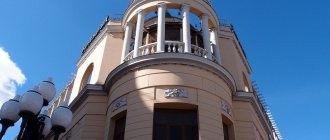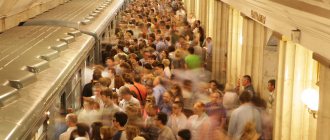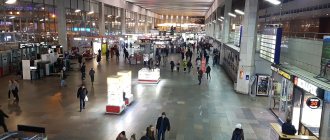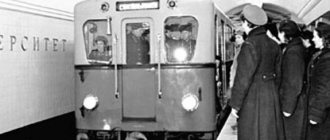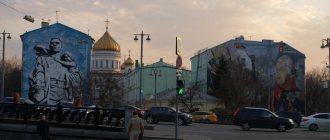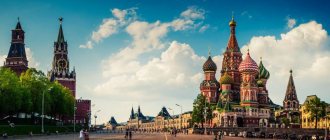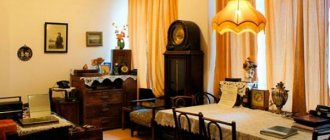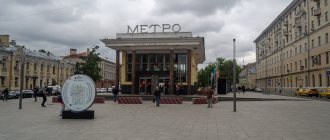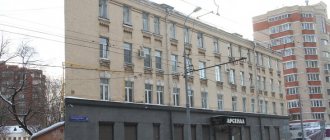For many centuries, the capital of Russia has been one of the most beautiful cities in the world, which can amaze anyone with its luxury, scale, as well as its rich architectural and cultural heritage. In Moscow you can easily find a place that suits your taste. After all, there is everything here, from colorful nightlife to world-famous museum centers with stunning collections of exhibits. However, even those tourists who, by the will of fate, find themselves passing through Moscow, with only a few hours left to explore local attractions, can contemplate the beauty. To do this, it’s enough to go down to the capital’s metro, which, without unnecessary modesty, is considered one of the most beautiful on the planet.
Today in Moscow, many subway stations are historical monuments that are classified as cultural heritage sites. According to Joseph Stalin, the Soviet metro should have become one of the symbols of the era. Therefore, huge amounts of money were invested in the construction, finishing and subsequent decoration of the stations. Needless to say, the stunning results justified even the wildest expectations. Thanks to the magnificent stained glass windows, luxurious decor, numerous statues, bas-reliefs and mosaic panels, they can easily be compared to “underground palaces”.
So, why don’t we talk today about seven stations of the Moscow metro, which, thanks to their beauty and unusualness, have always attracted people’s views.
Teatralnaya
at the station with the rather sonorous name “ Teatralnaya ” for a long time. Its peculiarity is the sculptural inserts on the theme of theatrical art of the USSR, which can be seen on the ceiling with diamond-shaped coffers and gilded bas-reliefs made of ceramics. The figures were created from glazed porcelain. Their silhouettes are of women and men dressed in national costumes. All of them are engaged in some kind of art: playing instruments or dancing.
Until 1990, the Teatralnaya station had a different name, “ Sverdlov Square ”.
A little history
The first line opened on May 15, 1935 and ran from Sokolniki station to Park Kultury station, with a branch to Smolenskaya. The Metropolitan originally bore the name of L. M. Kaganovich. Since 1955, the metro has been named after V.I. Lenin. Since 1992, the transport system itself has been predominantly referred to as the Moscow Metro.
In the fall of 1941, the metro was used as a bomb shelter, and some of the cars were evacuated. The resolution of the State Defense Committee of October 15, 1941 stipulated the destruction of metro equipment in the event of enemy troops appearing “at the gates of Moscow.”
Moscow Metro
Oktyabrskaya
Initially, the Oktyabrskaya was called differently - Kaluzhskaya , which was, one might say, quite logical, because one of the exits led to Kaluzhskaya Square. It was renamed in 1961.
The decoration is dedicated to the theme of victory over the invaders in the Great Patriotic War. Here you can see lamps on torch-shaped pylons, the floor is made of high-quality granite material.
The track walls are lined with light-colored tiles and decorated with wreaths with gold ornaments. Here is an arch to a bright future, above which the blue sky opens up to the eye.
Arbatskaya
" Arbatskaya " is one of the closest stations to Old Arbat. The station, magnificent in design, with an elliptical shape of the central hall, received the status of a cultural heritage site.
Developed according to a special project. The lower part of the pylons is decorated with red marble; on the walls you can see ceramic decorative elements with picturesque plant motifs.
The floors are decorated in a combination of marble colors: red, black and gray, imitating carpet patterns. The central hall, as well as the platforms, are illuminated by gilded chandeliers.
Taganskaya
The station is named after Taganskaya Square, where its lobby is located. There is one vestibule at the station, as well as one ground pavilion.
You want to stay here longer, because there is so much to see: when you go down the escalator, you find yourself in a beautiful entrance hall. This room is round in shape, with a spectacular domed ceiling. The dome is decorated with the “Victory Salute” fresco.
The platform part at the Taganskaya is incredibly beautiful, reminiscent of a Gothic castle, and its main decorations are arrow-shaped ceramic panels, reminiscent of Russian folk kokoshniks. The panels are absolutely fantastic, so you can come here as if you were visiting a museum!
Mendeleevskaya. Serpukhovsko-Timiryazevskaya line.
“Sympathy”
A terrible and at the same time sad story is connected with the monument to a stray dog on Mendeleevskaya, erected on February 17, 2007. The monument is dedicated to a mongrel named Boy, who used to live in an underground passage near the station. In 2001, the mongrel was killed by fashion model Yulia Romanova. The owners of the tents who fed the dog called the police and even an ambulance, but law enforcement agencies did not initiate a case, and they tried to hush up the story. The world is not without good people, and thanks to the support of animal rights activists, the girl was summoned to court, by which she was declared insane and sentenced to 1 year of treatment in a psychiatric hospital.
The inscription on the monument reads: “Sympathy. Dedicated to humane treatment of homeless animals." It makes you think about what the word “humanity” means and how important it is today.
Revolution square
In the niches of each of the arches of the Revolution Square there are bronze figures depicting USSR workers of various professions.
Initially, the architect Dushkin planned to make the station bright, but his co-author, Matvey Manizer, insisted that sculptures depicting people of the “new world”: miners, sailors, students be placed at the station. As a result, Matvey Manizer’s idea was realized, but the station turned out to be ponderous and the figures were “constrained.”
Nevertheless, Stalin liked Revolution Square. It also impresses tourists - they willingly stop to look at everything and take pictures.
Zamoskvoretskaya.
- Year of opening: 1938
- Number of stations: 21
- Time: 57 minutes
If you don't like visiting doctors, particularly dentists, I'm afraid this station is not for you. The illuminated bathhouses with Falcon niches resemble operating lamps, and the sounds of approaching trains and slamming doors can evoke not the most pleasant memories.
This station will delight both poetry lovers and architects. "Mayakovskaya" greets passengers with lines from the revolutionary's poems, and the design of the underground hall surprises with its lightness and impeccability. And this, by the way, is the world’s first deep column station.
The rigor and clarity of “Novokuznetskaya” will be the envy of any Soviet building. The station is somewhat reminiscent of the Italian catacombs, illuminated by electric torches.
Mayakovskaya
Sokol Novokuznetskaya
Novokuznetskaya
" Novokuznetskaya " was opened during the war. It is noteworthy that the theme of the station’s design is the heroic struggle of the Soviet people against the invaders during the Great Patriotic War; at the time the sketches were created, the war was still in full swing.
The station has one vestibule, located in a ground pavilion in the form of a rotunda. The pavilion is painted yellow. The interior space of Novokuznetskaya is richly decorated with bas-reliefs on the theme of heroism and patriotism of the peoples of the USSR during the war. On the ceiling there are six mosaic panels, which were made according to sketches by artist Alexander Daineko.
An interesting detail of the station is the marble benches, which were once taken from the Cathedral of Christ the Savior before its destruction.
Komsomolskaya
“ Komsomolskaya ” is classified as a “front” station, and this is not surprising, because it was designed by the legendary architect Aleksey Viktorovich Shchusev, the author of the Mausoleum. The decoration of the station was done by an equally famous artist - Pavel Korin.
When you enter the station, it seems that you find yourself in a palace - it is so solemn, spacious and beautiful that you don’t want to leave. The ceiling of Komsomolskaya is decorated with mosaic panels made of valuable stones and smalt. Magnificent architecture and brilliant decoration!
Interesting fact: majolica panels depicting those who participated in the construction of the station once received the Stalin Prize.
Berlin, Germany
The Berlin Underground has a rich and tragic history: it was seriously damaged during World War II, divided after the construction of the Berlin Wall, and reunited after its fall.
The “walking” sculpture of the German master Rolf Bible at the Vinetastraße station, a lattice decorated with knightly armor at Fehrbelliner Platz, paintings with views of Heidelberg at the Heidelberger Platz station, colorful panels at Paulsternstraße - getting to know the modern Berlin subway can only be compared to visiting a museum.
- 11 ways to make friends with Berlin
Mayakovskaya
" Mayakovskaya " is considered one of the most beautiful stations in Moscow, to understand why, it is worth seeing at least once. The futuristic station has an abundance of symbols and messages that were laid down during construction. In particular, the metal edging that influenced the architecture consists of fragments of an airship previously built according to Tsiolkovsky's design. Orlets plates were laid next to them - this is an extremely rare variety of semi-precious rhodonite.
The pride of Mayakovskaya is 34 mosaics made by the painter Daineko.
Interesting fact: in 1938 the station received the Grand Prix in New York, and in 1980 it won the status of an architectural monument. The project has become a classic that is looked up to even today.
The most beautiful Moscow metro stations: present and future
The Moscow metro is, without exaggeration, the most beautiful in the world. 44 of the nearly 190 metro stations are recognized as cultural heritage sites, that is, historical monuments. Let’s remember how this triumph began, and let’s also see what the metro will be like in the near future, in 2021.
At various times, such stations as “Mayakovskaya”, “Kropotkinskaya”, “Red Gate” were awarded international awards and were included in the textbooks of world architecture as examples of perfection of form and content. By the way, the first metro line “Sokolniki” - “Park Kultury” opened back in 1935. Here is one of the few photographs of those years, Muscovites going to work:
But, of course, the happy builders were the first to try the subway. By the way, the profession of a metro builder in those days became one of the most prestigious.
Mayakovskaya is considered the most beautiful station. Back in 1939, a year after its commissioning, the station project received the Grand Prix at the World's Fair in New York. And this was in the harsh Stalinist times!
During the war the station was used as a bomb shelter. On November 6, 1941, a meeting of the Moscow Council of Deputies was held here. Stalin himself spoke at it. He arrived at the station by train from the Belorusskaya direction. And here is a post-war photograph of the station, 1947:
The Ploshchad Revolutsii station opened in the same year as Mayakovskaya. According to the authors' plans, the hall contains sculptures depicting people and animals of the “new world”: sailors, soldiers, miners, students, a border guard with a dog and others.
In 1941, the sculptures were evacuated to Central Asia and returned after the end of the war. Many of them were damaged during transportation, but were fully restored.
The Novokuznetskaya station was opened at the height of the war, in 1943. The ceiling of the hall is decorated with six panels by Leningrad artist Vladimir Frolov. He made them while dying of hunger in a besieged city. These were his last works. The panel was taken out of the besieged city along the Road of Life. It is noteworthy that the station’s marble benches were removed from the Cathedral of Christ the Savior before its destruction.
All the pomp of the Stalinist Empire style was expressed in the architecture of Komsomolskaya. The theme of the design here is the struggle of the Russian people for independence. The ceiling of the station is decorated with eight mosaic panels made of smalt and precious stones. Six of them depict Alexander Nevsky, Dmitry Donskoy, Kuzma Minin and Dmitry Pozharsky, Alexander Suvorov, Mikhail Kutuzov, Soviet soldiers and officers at the walls of the Reichstag.
Here is a panoramic photo of the station taken by one craftsman from LiveJournal.
A special feature of the Teatralnaya station is sculptural inserts made of glazed porcelain on the theme of the theatrical art of the peoples of the USSR. The figures depict men and women in national costumes dancing or playing musical instruments. For some reason, out of the 11 Soviet republics that existed in 1938, only seven are represented here.
When designing the Novoslobodskaya station, the authors wanted to do something fabulous. And they succeeded. Muscovites dubbed the station an “underground fairy tale” and a “stone flower.”
Panoramic photo from an already familiar craftsman:
Station "Taganskaya", the share of the prisoners, the group "Lube" sang. The hall is decorated with figures depicting Soviet soldiers. By the way, during construction, the Church of St. Nicholas the Wonderworker, which was in the way, was almost demolished. However, thanks to skilled engineers, it was possible to save it.
Here is a Soviet photo from the 50s:
“Kyiv” on the ring is logically dedicated to Ukraine. 18 pylons of the station are decorated with mosaic panels on the theme of the history of Ukraine and the friendship of the Ukrainian and Russian peoples. At the end of the hall there is a large panel with Lenin and lines of the Soviet anthem. By the way, one of the exits from the station in 2006 was designed by French architects based on the model of the Paris Metro.
Prospekt Mira differs from other stations in that access to the city is through a ground-based vestibule built into a residential building. The lobby hall is decorated with a smalt panel “Mother of the World”.
VDNKh is one of the deepest stations of the Moscow metro. The depth is 53.5 meters, which is more than the height of a twelve-story building. The minimalism of the design of the station hall is diluted by round cast grilles on the ventilation holes and chandeliers with crystal lamps.
The Vystavochnaya station was opened quite recently, in 2005. And it was originally called “Business Center”. But then it was renamed due to its close location to Expocenter. The decoration here is made in the hi-tech style that is popular today, using glass and steel. On the second “floor” of the station there is a photo gallery.
But one of the latest stations is Novokosino. Opened last summer. Here, the design was based on minimalism and the currently fashionable grey-black-white palette. This is one of the first stations from Sergei Sobyanin’s global plan for metro development until 2020.
In total, by 2021, according to Sobyanin’s plan, 79 new stations will be built. The length of the metro will increase by 160 km in just seven years. You can get to distant Novoperedelkino or Khovrino from the center in 30-40 minutes. 90% of Muscovites will have the subway within walking distance. Design projects for some stations can already be assessed now. In them, minimalism is replaced by bright colors, and simple architectural forms are replaced by geometrically complex solutions. Time passes, and the metro gets better. Here are some of the sketches.
"Street of the 800th anniversary of Moscow"
"Spartacus"
"Seligerskaya"
"Ramenki"
"Lomonosovsky Prospekt"
"Kosino-Ukhtomskaya"
"Zhulebino"
Novoslobodskaya
Immediately after the opening of the Novoslobodskaya , the indigenous residents of Moscow dubbed it the “Stone Flower”, “Underground Fairy Tale”. To earn such titles, you will most likely agree, you had to make an incredible impression!
The station's architecture is incredibly simple, but this is where its highlight lies. This simplicity was so thought out that people are trying to emulate it.
The main decoration of Novoslobodskaya is 32 stained glass windows of incredible beauty. It is noteworthy that the glass was brought from the Riga Cathedral, and the ornaments were borrowed from the books of Orthodox priests. The panel “World Peace” was created on the model of icons of the Mother of God by icon painter Pavel Dmitrievich Korin.
2 0
